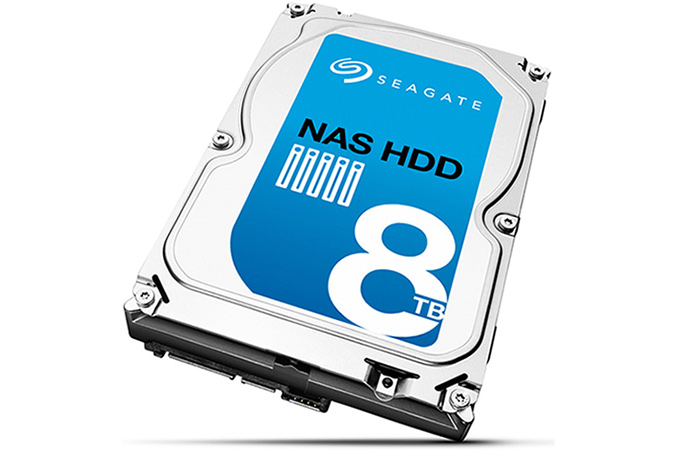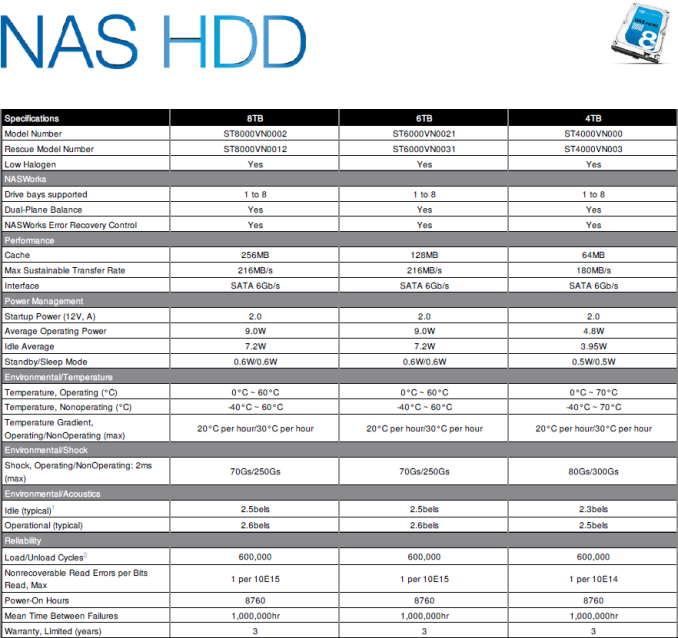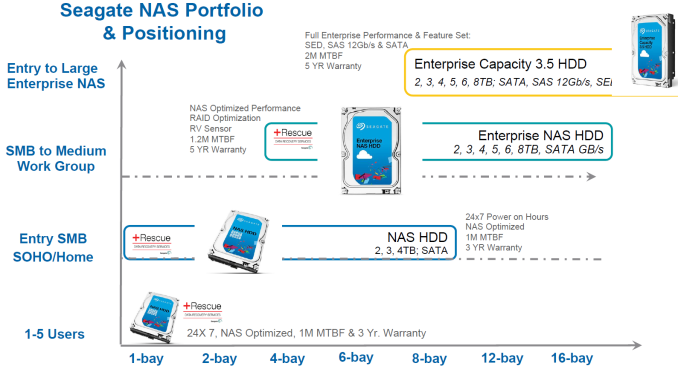Seagate Introduces First 8 TB Hard Disk Drive for Consumer NAS Applications
by Anton Shilov on January 12, 2016 7:05 PM EST
Seagate Technology on Tuesday introduced its new breed of hard disk drives (HDDs) for network area storage (NAS) and RAID applications. The new family of NAS HDDs from Seagate includes a model with 8 TB capacity, which is the industry’s first hard drive of such kind that is targeted towards small and medium businesses as well as personal use, i.e, 1-8 bay NAS units.
Seagate’s 8 TB 3.5-inch NAS HDD is based on six perpendicular magnetic recording (PMR) platters with 1.33 TB capacity each. The hard drive features 7200 revolutions per minute spindle speed, 256 MB DRAM cache as well as a Serial ATA interface. The manufacturer declares 216 MB/s maximum sustainable media to cache transfer rate, which is considerably higher compared to previous-generation drives. The new HDD have average operating power of 9 W as well as average idle power of 7.2 W.
Seagate’s latest family of NAS HDDs also includes models with 6 TB, 4 TB, 3 TB, 2 TB and 1 TB capacities. Hard drives with 6 TB and 8 TB capacities have spindle speed of 7200 RPM, whereas the remaining drives feature 5900 RPM speed.
High-capacity PMR platters, 7200 RPM spindle speed as well as massive 256 MB DRAM cache will help the new 6TB and 8 TB drives to offer very high random read performance, which should be useful not only for NAS environments, but for desktops as well.
Previously Seagate offered 8 TB drives for archive/nearline, enterprise capacity and enterprise NAS applications. Such drives are optimized for servers, racks, maximum reliability, etc., which comes at a price. The new 8 TB HDD for small and medium businesses (SMBs) as well as creative professionals are designed for tower enclosures with one to eight bays and are essentially the first hard drives with such capacity that are optimized for desktop applications. The drives are also fully compatible with select NAS products from companies like ASUSTOR, QNAP, Synology and Thecus.
Hard disk drives for SMB NAS applications use platforms that were developed to handle additional vibration, hence, they are more reliable than desktop-class HDDs, but are less advanced that enterprise-class hard drives. NAS HDDs usually feature dual plane balance control, improved heads as well as special firmware.
Seagate’s NAS HDDs compete against Western Digital’s WD Red lineup. At present, the maximum capacity offered by the WD Red is 6 TB, hence, with 8 TB offerings Seagate will have a competitive advantage over its rival when it comes to NAS hard drives.
The new Seagate NAS HDD 8TB has shipped to select customers. Wide-scale availability is expected at the end of the Q1 2016. Consumers should be on the lookout for the ST8000VN0002 or ST8000VN0012 models, as they are the PMR ones. Seagate also has a ST8000VN000 model which uses host-aware SMR (shingled magnetic recording).The MSRP of the new 8TB PMR NAS HDD from Seagate will be $385 when it ships later this quarter.
Source: Seagate


















38 Comments
View All Comments
ZeDestructor - Tuesday, January 19, 2016 - link
for individual desktop drives, not so much. For those of us building larger arrays using the new high-density chassis options (30+ drives in 4U), the costs of replacing failed lower-end drives is often cheaper than buying higher-end enterprise drives, and for that, backblaze' data is extremely valuable.eddman - Wednesday, January 13, 2016 - link
Is it ok to use an NAS drive as a main drive on a PC, or should I use a desktop specific drive? Are there any special firmware differences?extide - Wednesday, January 13, 2016 - link
You would be fine, I'm sure.eldakka - Wednesday, January 13, 2016 - link
Apart from physical construction differences (Enterprise/NAS drives being able to handle more vibration), the other main difference is the behaviour when the drive encounters a read error.On a desktop drive, when the drive detects a read-error, it'll attempt to read the sector again, and again, and again and...until after some firmware-defined number of retries it gives up and reports a read-error back to the O/S (or succeeds at which point the data is successfully read). This process can take several minutes, possibly 10's of minutes.
In enterprise and NAS HDDs, the assumption is that these drives are most likely going to be put into some sort of redundant array, whether hardware or software RAID or some other software that can handle errors (ZFS etc). In this case, if there is a read-error, report the error immediately to host system (RAID controller, RAID software, etc.) and do not waste time re-reading the sector. The data can be rebuilt from the RAID array, therefore there is no need to waste time trying to re-read the data, doesn't matter if the drive can rebuild the data or not, it can be retrieved from another member of the array. And, since the chances are that if it's being put into a RAID array, it'd PROBABLY a multi-user system, with 10's, 100's, 1000's of disparate simultaneous request for data, such as in, say, a 100TB SAN array. You don't want to hold up those other accesses for minutes trying to re-read data that can be recovered at a tiny overhead from the RAID array.
Therefore in a desktop or other non-RAID-like configuration, the data reliability may in fact be worse, as it won't retry a failed read.
However, one other significant difference with enterprise/NAS drives, is that there are often software tools to access the drives firmware and configure such parameters (read re-tries etc) which in consumer/desktop drives are often locked-out, or the tools just aren't available from the manufacturer.
willis936 - Wednesday, January 13, 2016 - link
The world's most timevefficient way to destroy data.nwarawa - Thursday, January 14, 2016 - link
Everytime a HDD article... "Avoid WD" this and "Seagate, never again" that. Take it from a system builder: just avoid their budget lines. Both WD Greens and the standard Seagate Barracudas suck. Ever since I switched to WD red/se and Seagate es, not a single failure.I hate fanboys - Thursday, February 18, 2016 - link
Hey all fanboys and other ignorant corn holes (if you can read):http://arstechnica.com/information-technology/2016...
xicaque - Sunday, October 23, 2016 - link
I've had mixed feelings about Seagates.